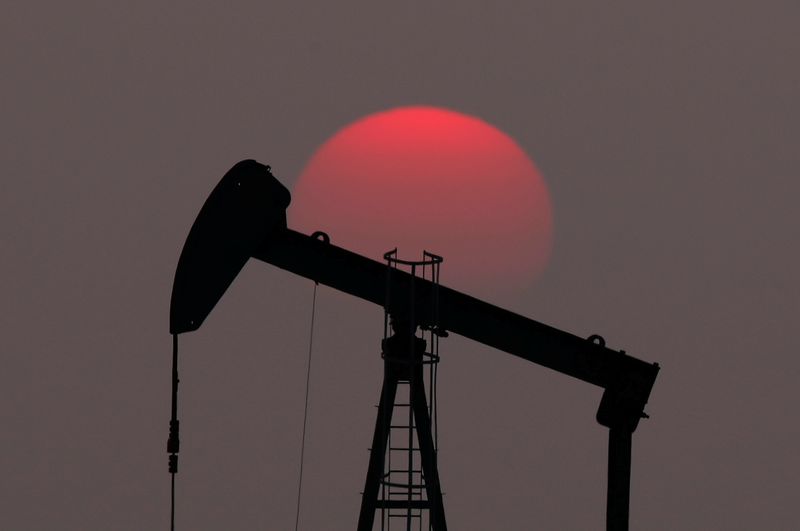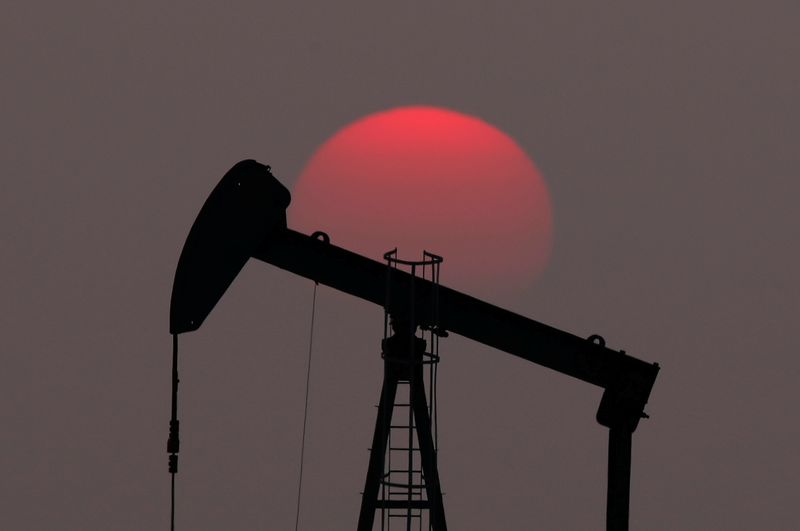Commodities
Analysis-Big Oil’s bid to woo ESG investors fails to impress


© Reuters. The sun sets behind an oil pump outside Saint-Fiacre, near Paris, France March 28, 2019. REUTERS/Christian Hartmann/File Photo
By Simon Jessop and Tommy Wilkes
DUBAI (Reuters) – A COP28 pledge by energy majors to reduce their emissions is not enough to convince many sustainable fund managers to include the companies in their portfolios because it omits pollution from the use of oil and gas, six interviews with Reuters show.
The pledge by 50 of the biggest oil and gas companies at the U.N. climate talks in Dubai commits to reaching near-zero methane emissions by 2030 as well as net-zero carbon emissions in their energy use and production by 2050.
Those Scope 1 and 2 emissions from the companies’ own operations account for about 15% of the total associated with the companies. The pledge does not address Scope 3 emissions caused by the use of the fuels the companies produce that account for 85%.
Although some of the energy companies had already made promises ahead of the COP28 announcement, several state-owned firms have newly joined in.
Investors in socially responsible, often known as ESG (environmental, social and governance), funds, said the commitments were overdue and not enough.
Asset manager Candriam said it would stick to excluding major oil and gas companies from its socially responsible funds because none was aligned with their preferred scenario for meeting the objectives of the Paris Agreement on climate change. The agreement calls for limiting global warming to within 2 degrees Celsius (3.6 Fahrenheit), and aims for a 1.5C limit.
Meeting that goal requires cutting global emissions by 43% by 2030 and to net-zero by 2050.
“The transition to a low-carbon world does not mean producing the same volume of oil and gas in a more carbon efficient manner. It means shifting away from fossil fuels as the main energy source towards low-carbon energy,” Alix Chosson, lead ESG analyst at Candriam, said.
The COP28 talks, hosted by OPEC-member the United Arab Emirates, have attracted a record attendance from the oil and gas industry while delegates are divided over wording on the future of fossil fuels.
‘STEP FORWARD’ BUT NOT FAR ENOUGH
ESG funds have long wrestled with how to approach conventional energy producers.
Some exclude them out of scientific principle. Others say divesting has no impact and it is better to try and persuade them to pollute less, which means making them responsible for Scope 3 emissions.
Kamal Bhatia, global head of investments at Principal Asset Management, said fossil fuel companies without energy transition strategies do not “environmentally 100% meet the definition” to be included in pure ESG funds.
At an industry dinner in Dubai last week, Leon Kamhi, head of responsibility at asset manager Federated Hermes (NYSE:), said the companies’ pledge announced at the talks was a “big step forward”, but not enough.
Only one – Italy’s Eni – of the 25 biggest oil and gas companies is aligned with the Paris Agreement, according to Carbon Tracker’s assessment.
SHIFTING ECONOMICS
As war in Ukraine sent fossil fuel prices soaring, ESG fund holdings in the sector increased. At the same time, a cost of living crisis in many parts of the world shifted the focus away from sustainable investment and back towards the most easily achieved shareholder returns.
The proportion of U.S.-domiciled sustainable open-ended funds and exchange traded funds that owned oil and gas stocks hit 49% in September, against 43% three years earlier, Morningstar data show. Among conventional funds, the share with oil and gas holdings rose to 68% from 45% over the same period.
But as energy prices weaken, funds’ exposure to oil and gas is also shrinking.
The average exposure to oil and gas stocks for the U.S.-domiciled funds hit 1.86% in September, versus 2% in late 2022, a faster rate of decline than for conventional funds, which had 5.3% exposure in September, according to the data.
Funds marketed as sustainable in the European Union saw average exposure to oil and gas fall to 2.43% in September, from a peak of 3.33% in late 2022, the data show.
Sustainability-minded investors have achieved little when trying to influence oil giants as stakeholders, U.S. billionaire environmentalist Tom Steyer told Reuters in Dubai.
“A bunch of people have bought into Exxon to try and change it, and Exxon’s response was to spend [on buying a rival],” he said, referring to ExxonMobil (NYSE:)’s $60 billion deal to acquire Pioneer Natural Resources (NYSE:).
“It’s very important to recognise how hard it is to change 100-year-old corporate cultures,” he said.
MISSING RENEWABLES
For some ESG investors, the case for investing in the energy giants has been weakened by the realisation “oil and gas companies are not going to become renewable energy companies”, Global Head of Sustainability and Transition Strategy at U.S. bank Jefferies Aniket Shah said.
Oil and gas companies have cut spending on production in favour of shareholder payouts. Of every $10 in cash spent in 2022, less than $5 went into capital expenditure, compared with $8.6 in 2008, the International Energy Agency calculates.
By comparison, the amount spent on low-carbon capital expenditure last year was 10 cents of every $10.
That has created credibility issues the COP28 commitments are unlikely to dispel.
“If a certain energy provider is communicating ‘we are now really going for a different form of source and delivery’, then the trust really has to still develop,” said Gunther Thallinger, chair of the U.N.-convened Net-Zero Asset Owners Alliance and board director at Germany’s Allianz (ETR:).
Commodities
Oil prices rise; U.S. crude inventories plunge, Russia-Ukraine truce eyed
Commodities
India’s Reliance to stop buying Venezuelan oil over US tariffs, sources say
Commodities
Oil prices climb on Venezuela supply worries

 Forex3 years ago
Forex3 years agoForex Today: the dollar is gaining strength amid gloomy sentiment at the start of the Fed’s week

 Forex3 years ago
Forex3 years agoUnbiased review of Pocket Option broker

 Forex3 years ago
Forex3 years agoDollar to pound sterling exchange rate today: Pound plummeted to its lowest since 1985

 Forex3 years ago
Forex3 years agoHow is the Australian dollar doing today?

 Cryptocurrency3 years ago
Cryptocurrency3 years agoWhat happened in the crypto market – current events today

 World3 years ago
World3 years agoWhy are modern video games an art form?

 Commodities3 years ago
Commodities3 years agoCopper continues to fall in price on expectations of lower demand in China

 Economy3 years ago
Economy3 years agoCrude oil tankers double in price due to EU anti-Russian sanctions























